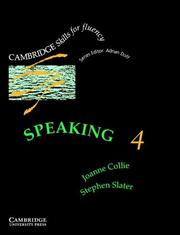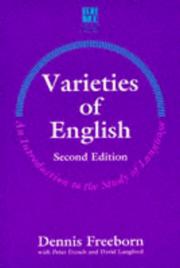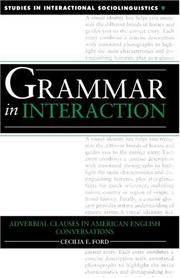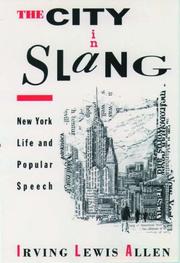| Listing 1 - 7 of 7 |
Sort by
|
Book
ISBN: 0521367492 9780521367493 Year: 1993 Publisher: Cambridge: Cambridge university press,
Abstract | Keywords | Export | Availability | Bookmark
 Loading...
Loading...Choose an application
- Reference Manager
- EndNote
- RefWorks (Direct export to RefWorks)
Book
ISBN: 058208539X 058208542X 9780582085428 9780582085398 Year: 1993 Publisher: Harlow: Longman,
Abstract | Keywords | Export | Availability | Bookmark
 Loading...
Loading...Choose an application
- Reference Manager
- EndNote
- RefWorks (Direct export to RefWorks)

ISBN: 0521399726 9780521399722 Year: 1993 Publisher: Cambridge : Cambridge university press,
Abstract | Keywords | Export | Availability | Bookmark
 Loading...
Loading...Choose an application
- Reference Manager
- EndNote
- RefWorks (Direct export to RefWorks)

ISBN: 0333589165 0333589173 9780333589175 Year: 1993 Publisher: Basingstoke: MacMillan,
Abstract | Keywords | Export | Availability | Bookmark
 Loading...
Loading...Choose an application
- Reference Manager
- EndNote
- RefWorks (Direct export to RefWorks)
English language --- Dialectology --- Anglais (Langue) --- Dialects --- Study and teaching --- Terms and phrases --- Grammar --- Dialectes --- Etude et enseignement --- Mots et locutions --- Grammaire --- Variation --- Problems, exercises, etc. --- History --- Standardization --- Spoken English --- English language - Variation - Problems, exercises, etc. --- English language - History - Problems, exercises, etc. --- English language - Standardization - Problems, exercises, etc. --- English language - Spoken English - Problems, exercises, etc. --- ENGLISH LANGUAGE --- VARIETIES
Book
ISBN: 9065695885 9789065695888 Year: 1993 Volume: 146 Publisher: Brussel: Koninklijke academie voor wetenschappen, letteren en schone kunsten van België,
Abstract | Keywords | Export | Availability | Bookmark
 Loading...
Loading...Choose an application
- Reference Manager
- EndNote
- RefWorks (Direct export to RefWorks)
English language --- Grammar --- Pragmatics --- Anglais (langue) --- Causaliteit --- Causalité --- Causation --- Engels --- Linguistique --- Oorzakelijkheid --- Taalkunde --- Causative. --- Syntax. --- Spoken English --- Conjunctions. --- 802.0-56 --- -English language --- -Germanic languages --- Engels: syntaxis; semantiek --- Causative --- Syntax --- -Conjunctions --- Engelse spraakkunst --- taalgebruik --- -Engels: syntaxis; semantiek --- 802.0-56 Engels: syntaxis; semantiek --- Engelse spraakkunst. --- taalgebruik. --- -802.0-56 Engels: syntaxis; semantiek --- Germanic languages --- pragmatics --- grammar [discipline] --- Conjunctions --- English language - Causative. --- English language - Syntax. --- English language - Spoken English - Great Britain. --- English language - Conjunctions. --- Conjonctions (grammaire)

ISBN: 0521418038 0521023750 0511554273 9780521418034 9780511554278 9780521023757 Year: 1993 Volume: 9 Publisher: Cambridge : Cambridge university press,
Abstract | Keywords | Export | Availability | Bookmark
 Loading...
Loading...Choose an application
- Reference Manager
- EndNote
- RefWorks (Direct export to RefWorks)
Cecilia E. Ford explores the question: what work do adverbial clauses do in conversational interaction? Her analysis of this predominating conjunction strategy in English conversation is based on the assumption that grammars reflect recurrent patterns of situated language use, and that a primary site for language is in spontaneous talk. She considers the interactional as well as the informational work of talk and shows how conversationalists use grammar to coordinate their joint language production. The management of the complexities of the sequential development of a conversation, and the social roles of conversational participants, have been extensively examined within the sociological approach of Conversation Analysis. Dr Ford uses Conversation Analysis as a framework for the interpretation of interclausal relations in her database of American English conversations. Her book contributes to a growing body of research on grammar in discourse, which has until recently remained largely focused on monologic rather than dialogic functions of language.
Sociolinguistics --- English language --- Grammar --- Pragmatics --- Americanisms --- Conversation --- Américanismes --- Anglais (Langue) --- Social aspects --- Spoken English --- Adverbials --- Clauses --- Aspect social --- Anglais parlé --- Locutions et propositions adverbiales --- Propositions --- Americanisms. --- Conversation. --- Adverbials. --- Clauses. --- 802.0-56 --- -English language --- -Germanic languages --- Talking --- Colloquial language --- Etiquette --- Oral communication --- Engels: syntaxis; semantiek --- -Spoken English --- -Adverbials --- Provincialisms --- Dialects --- -Engels: syntaxis; semantiek --- 802.0-56 Engels: syntaxis; semantiek --- -Talking --- Américanismes --- Anglais parlé --- Germanic languages --- Arts and Humanities --- Language & Linguistics --- English language - United States - Adverbials. --- English language - Spoken English - United States. --- English language - Social aspects - United States. --- English language - United States - Clauses. --- -Social aspects

ISBN: 0195092651 0195357760 1429406615 9781429406611 1280527692 9781280527692 9780195075915 0195075919 9780195092653 0195075919 0190282452 Year: 1993 Publisher: New York : Oxford University Press,
Abstract | Keywords | Export | Availability | Bookmark
 Loading...
Loading...Choose an application
- Reference Manager
- EndNote
- RefWorks (Direct export to RefWorks)
The American urban scene, and in particular New York's, has given us a rich cultural legacy of slang words and phrases, a bonanza of popular speech. Hot dog, rush hour, butter-and-egg man, gold digger, shyster, buttinsky, smart aleck, sidewalk superintendent, yellow journalism, breadline, straphanger, tar beach, the Tenderloin, the Great White Way, to do a Brodie--these are just a few of the hundreds of popular words and phrases that were born or took on new meaning in the streets of New York. In The City in Slang, Irving Lewis Allen traces this flowering of popular expressions that accompanied the emergence of the New York metropolis from the early nineteenth century down to the present. This unique account of the cultural and social history of America's greatest city provides ineffect a lexicon of popular speech about city life. With many stories Allen shows how this vocabulary arose from city streets, often interplaying with vaudeville, radio, movies, comics, and the popular songs of Tin Pan Alley. Some terms of great pertinence to city people today have unexpectedly old pedigrees. Rush hour was coined by 1890, for instance, and rubberneck dates to the late 1890s and became popular in New York to describe the busloads of tourists who craned their necks to see the tall buildings and thesights of the Bowery and Chinatown. The Big Apple itself (since 1971 the official nickname of New York) appeared in the 1920s, though first in reference to the city's top racetracks and to Broadway bookings as pinnacles of professional endeavor. Allen also tells fascinating stories behindonce-popular slang that is no longer in use. Spielers, for example, were the little girls in tenement districts who danced ecstatically on the sidewalks to the music of the hurdy-gurdy men and, when they were old enough, frequented the dance halls of the Lower East Side. Following the trail of these words and phrases into the city's East Side, West Side, and all around the town, from Harlem to Wall Street, and into the haunts of its high and low life, The City in Slang is a fascinating look at the rich cultural heritage of language about city life.
English language --- New York (N.Y.) --- Slang --- Social aspects --- Spoken English --- Popular culture --- New York (State) --- Social life and customs --- City and town life --- Terminology --- Americanisms --- Americanisms -- New York (State) -- New York. --- City and town life -- Terminology. --- English language -- New York (State) -- New York -- Slang. --- English language -- Social aspects -- New York (State) -- New York. --- English language -- Spoken English -- New York (State) -- New York. --- New York (N.Y.) -- Social life and customs. --- Popular culture -- New York (State) -- New York. --- Germanic languages --- City life --- Town life --- Urban life --- Sociology, Urban --- Terminology. --- Slang. --- Dialects --- Social life and customs. --- ENGLISH LANGUAGE --- U.S. --- SLANG
| Listing 1 - 7 of 7 |
Sort by
|

 Search
Search Feedback
Feedback About UniCat
About UniCat  Help
Help News
News